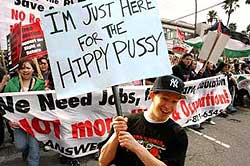This is not to say that his analysis isn't astute, for it very much is. He divides the nation into five regions:
1. The Coastal Megalopolises.
New York, Los Angeles/Orange County, San Francisco/Oakland/San Jose, San Diego, Chicago (on the coast of Lake Michigan), Miami, Washington/Baltimore and Boston. Here is a pattern you don't find in other big cities: Americans moving out and immigrants moving in, in very large numbers, with low overall population growth. Los Angeles, defined by the Census Bureau as Los Angeles and Orange Counties, had a domestic outflow of 6% of 2000 population in six years--balanced by an immigrant inflow of 6%. The numbers are the same for these eight metro areas as a whole.Gee, could it be that the "distaste" for the "burgeoning immigrant populations"is due to the fact that too many of them are arriving too fast and contributing to high housing costs, and too many of them are net takers of social services, contributing to high taxes? And that's the better and legal ones. Meanwhile the illegal aliens contribute crime and drugs. But the Wall Street Journal just keeps on whistling past the national graveyard, and disrespecting patriotic Americans who don't like what has happened to their country.
There are some variations. New York had a domestic outflow of 8% and an immigrant inflow of 6%; San Francisco a whopping domestic outflow of 10% (the bursting of the tech bubble hurt) and an immigrant inflow of 7%. Miami and Washington had domestic outflows of only 2%, overshadowed by immigrant inflows of 8% and 5%, respectively.
This is something few would have predicted 20 years ago. Americans are now moving out of, not into, coastal California and South Florida, and in very large numbers they're moving out of our largest metro areas. They're fleeing hip Boston and San Francisco, and after eight decades of moving to Washington they're moving out. The domestic outflow from these metro areas is 3.9 million people, 650,000 a year. High housing costs, high taxes, a distaste in some cases for the burgeoning immigrant populations--these are driving many Americans elsewhere.
Mr. Barone goes on:
(Democrat) politicians like to decry what they describe as a widening economic gap in the nation. But the part of the nation where it is widening most visibly is their home turf, the place where they win their biggest margins (these metro areas voted 61% for John Kerry) and where, in exquisitely decorated Park Avenue apartments and Beverly Hills mansions with immigrant servants passing the hors d'oeuvres, they raise most of their money.
The result is that these Coastal Megalopolises are increasingly a two-tiered society, with large affluent populations happily contemplating (at least until recently) their rapidly rising housing values, and a large, mostly immigrant working class working at low wages and struggling to move up the economic ladder. The economic divide in New York and Los Angeles is starting to look like the economic divide in Mexico City and São Paulo.But Mr. Barone won't admit that his paper's immigration policies have just about everything to do with that. Indeed, the Wall Street Journal policies have turned once reasonably and even solidly conservative areas of California (Orange County, San Jose, Contra Costa County) into elitist liberal zones.
The bad news for them is that the Coastal Megalopolises grew only 4% in 2000-06, while the nation grew 6%. Coastal Megalopolitan states--New York, New Jersey, Massachusetts, Illinois--are projected to lose five House seats in the 2010 Census, while California, which has gained seats in every census since it was admitted to the Union in 1850, is projected to pick up none and may even lose one.So where are the middle and working class people fleeing the Coastal Megalopolises going? They are going to:
2. Interior Boomtowns (none touches the Atlantic or Pacific coasts).
Their population has grown 18% in six years. They've had considerable immigrant inflow, 4%, but with the exceptions of Dallas and Houston, this immigrant inflow has been dwarfed by a much larger domestic inflow--three million to 1.5 million overall.
Domestic inflow has been a whopping 19% in Las Vegas, 15% in the Inland Empire (California's Riverside and San Bernardino Counties, where much of the outflow from Los Angeles has gone), 13% in Orlando and Charlotte, 12% in Phoenix, 10% in Tampa, 9% in Jacksonville.
Domestic inflow was over 200,000 in the Inland Empire, Phoenix, Atlanta, Las Vegas and Orlando. These are economic dynamos that are driving much of America's growth. There's much less economic polarization here than in the Coastal Megalopolises, and a higher percentage of traditional families: Natural increase (the excess of births over deaths) in the Interior Boomtowns is 6%, well above the 4% in the Coastal Megalopolises.
The nation's center of gravity is shifting: Dallas is now larger than San Francisco, Houston is now larger than Detroit, Atlanta is now larger than Boston, Charlotte is now larger than Milwaukee. State capitals that were just medium-sized cities dominated by government employees in the 1950s--Sacramento, Austin, Raleigh, Nashville, Richmond--are now booming centers of high-tech and other growing private-sector businesses. San Antonio has more domestic than immigrant inflow even though the border is only three hours' drive away. The Interior Boomtowns generated 38% of the nation's population growth in 2000-06.In other words, Republicans fleeing one desirable coastal areas from which they once could be elected. Why is Mr. Barone trying to call this a Republican victory, when it's really a retreat? A retreat in the face of immigrants to whom the Wall Street Journal tries to Hispander, to no avail? Two thirds will hate the Republicans anyway. And it wasn't like these interior cities were not voting Republican already. But the WSJ just keeps on dreaming...
This is another political world from the Coastal Megalopolises: the Interior Boomtowns voted 56% for George W. Bush in 2004. Texas, Arizona, Florida, Georgia and Nevada--states dominated by Interior Boomtowns--are projected to pick up 10 House seats in the 2010 Census.
One other stubborn fact remains: Not everybody is moving by choice. Coastal cities have some of the most expensive housing costs in the country; many of the people who've moved inland still work at jobs within 10 miles of the ocean, and their 75-100 mile daily treks contribute to the nation's worst traffic commutes. (Think Sacramento to Bay Area, or San Berdoo/Riverside to LA). If you ask many inland people if they would move back to the coast if housing costs for pleasant neighborhoods were not a factor, most say yes.
The other three regions consist of:
3. The Rust Belt Cities. (One could argue Chicago belongs here, not in Coastal Megalopolis Category 1)
Their domestic outflow of 4% has been only partially offset by an immigrant inflow of 1%. If the outflow seems smaller than in the 1980s, it's because so many young people have already left. Natural increase is only 2%, lower than in Orlando or Jacksonville in supposedly elderly Florida. Their economies are ailing, more of a drag on, than an engine for, the nation. They're not the source of dynamism they were 80 or 100 years ago. They continue to vote Democratic, but their 54% for John Kerry was much lower than the Coastal Megalopolis's 61%. Their states are projected to lose six House seats in the 2010 Census.4. "The Static Cities".
These are 18 metropolitan areas with immigrant inflow between zero and 4%, with domestic inflow up to 3% and domestic outflow no higher than 1%. They seem to be holding their own economically, but are not surging ahead and some are in danger of falling back. Philadelphia makes the list, and so do Baltimore, Hartford and Providence in the East.5. The Countryside.
Surprisingly, some Western cities that boomed in the 1990s are in this category too: Seattle (the tech bust again), Denver, Portland. In the Midwest, Minneapolis, St. Louis, Cincinnati, Kansas City, Columbus and Indianapolis are doing better than their Rust Belt neighbors and make the list. In the South, Norfolk, Memphis, Louisville, Oklahoma City and Birmingham are lagging enough behind the Interior Boomtowns to do so. Overall the Static Cities had a domestic inflow of just 18,000 people (.048%) and an immigrant inflow of 2%. Politically, they're a mixed bag, a bit more Democratic than the nation as a whole: 52% for Kerry, 47% for Bush.
What of the rest of the nation? You can find a few smaller metro areas that look like the Coastal Megalopolises (Santa Barbara, university towns like Iowa City), many that resemble the Interior Boomtowns (Fort Myers, Tucson) and the Rust Belt (Canton, Muncie). You can find rural counties that are losing population (as are most counties in North Dakota) and, even amid them, towns that have solid growth (Fargo, Bismarck).What's now in store is a shifting of political weight from a small Rust Belt which leans Democratic and from the much larger Coastal Megalopolises, where both secular top earners and immigrant low earners vote heavily Democratic, toward the Interior Megalopolises, where most voters are private-sector religious Republicans but where significant immigrant populations lean to the Democrats. House seats and electoral votes will shift from New York, New Jersey and Illinois to Texas, Florida, Georgia, Arizona and Nevada; within California, House seats will shift from the Democratic coast to the Republican Inland Empire and Central Valley.
But overall the nation beyond these 49 metro areas looks like the Static Cities: 1% domestic inflow, 1% immigrant inflow, 4% population growth. But politically it is more Republican, taking in as it does large swathes of the South, Great Plains and Rocky Mountains, and in line with the historical record of non-metropolitan areas being less Democratic than metro areas: 56% for Bush, 42% for Kerry.
But given the immigration factor, that isn't exactly comforting for Republicans.
Another writer, Steve Sailer, commented on this phenomenon: He called it "Affordable Family Formation".











No comments:
Post a Comment